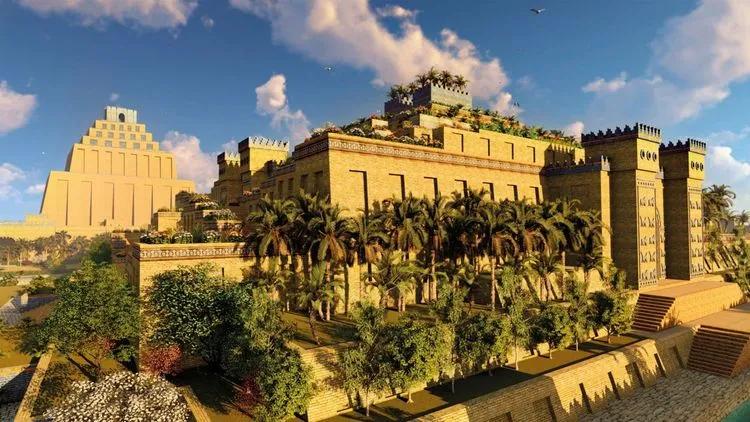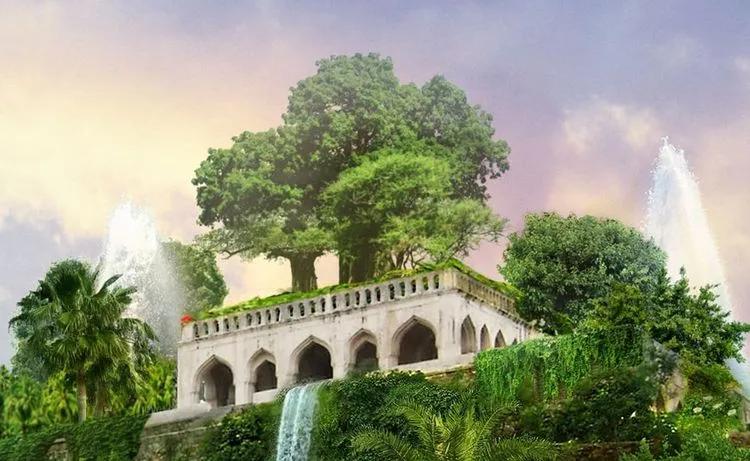The Seven Wonders of the Ancient World remind us that human imagination is limitless. Even though most of these Wonders aren’t around now, except for the Great Pyramid of Giza, they still excite us! The Gardens of Babylon used to be one of them, so let’s learn why people are still wondrous about them?

How the Gardens of Babylon Looked Like?
Plants and trees there weren’t growing on earth but on upper terraces. This construction was supported by stone columns. So to be precise, these gardens weren’t hanging. They were somewhat above the ground because of these terraces. A lot of plants were local, but some of them were imported—for example, cedar, plums, olives, willow, cypress, myrtle, etc.
The most important part of this creation is its size and height. Of course, it had to be colossal. Diodorus stated that it was about 400 ft wide and 400 ft tall, and the height of the walls was 80 ft. Another interesting fact: these gardens were built like a theater so that Babylonians could go up and down gradually. Sir Leonard Wolley supposes that the Hanging Gardens were built within the royal palace of Babylon.
History (And Myths) Behind the Creation of the Gardens of Babylon
There are different theories around these gardens. According to the Babylonian priest and scholar Berossus, Nebuchadnezzar II built these gardens for his wife, Amytis. She was from Media (somewhere near modern Iran) and missed the nature of her motherland. Her husband decided to recreate landscapes that were familiar to her.
Diodorus Siculus, the ancient Greek historian, however, disagreed. He stated that the gardens were created later by the Syrian king for one of his concubines.
Sometimes you can stumble on the third version that semi-legendary queen-regent Semiramis was the one who ordered the planting of these gardens. Modern historian Stephanie Dalley is more extravagant: she thinks King Sennacherib built the Hanging Gardens.

Where Were They Located?
Babylonia was a powerful state in ancient Mesopotamia. The ruins of this once powerful country now remain in modern-day Iraq. The city of Babylon used to take place near Hillah, province of Babil. In the 20th century, many German archeologists had spent too much time there (nearly two decades) to find any evidence that these hanging gardens existed. But they weren’t so lucky.
We have already mentioned Stephanie Dalley, and she thinks that we should leave Babylon in peace and focus on the Assyrian empire. To be exact, the scientist claims that more attention should be paid to the city Nineveh (now it’s a suburb of Mosul, north Iraq). Dalley found something interesting in the old texts of king Sennacherib. There he stated that he built a place that can amaze people. Also, he mentioned the irrigation system that was supposedly used to water the Babylonian gardens.
How Were the Gardens Functioning?
Since these gardens were built to resemble a completely foreign to this region mountainous landscape, there is no surprise that plants and trees there weren’t native. Probably, you wonder how different plants could thrive without their original soil. A good watering system is a key, that’s for sure. And don’t forget, it’s a challenge to keep plants alive, much less flourishing in the literal desert!
And it’s a moment when the location, which was close to the river Euphrates, came in handy because the irrigation system could rely on it. Diodorus wrote that watering mechanisms weren’t visible, so there could be no water wheels. Scientists assume that Babylonians needed about 8 200 gallons of water every day to properly irrigate this wonderful garden.
Were They Even Real?
Ancient history can be really tricky because we don’t have enough proof. That’s why in this case, scientists have two opposing views: some are sure these gardens were fictional; others are convinced they really existed. The ones who don’t believe always refer to the fact that no extant Babylonian manuscript mentioned these gardens. There is no archeological evidence of them. And since there were a lot of different royal gardens on the east, the Hanging Gardens of Babylon could be like an idealized version of all of them. Others who believe don’t lose hope quickly and cite ancient Greek authors. They don’t exclude the possibility that they were located somewhere else.

It doesn’t matter if the Hanging Gardens of Babylon had existed at all. What is really important is that they still captivate our imagination. And even more, they remind us that such regular things as gardens can be glorious.
FAQ
Which Plants Would Be Historically Accurate for a Recreated Hanging Garden?
A recreated Hanging Garden would likely include plants common to ancient Mesopotamia, such as date palms, figs, pomegranates, olives, willows, and cypress.
